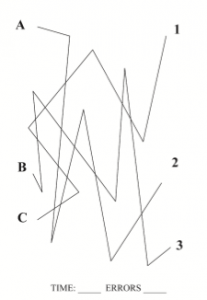Groffman Visual Tracing
Review Approaching Therapy and Good Stress: Task Loading if you haven’t read it in a while as the content is often expanded and updated.
Groffman Visual Tracing is more of a technique than an activity. The idea is very simple: Draw a column of digits (say 1 to 4), and a column of letters (a to d) beside. Join a digit to a letter using a curved or jagged line, it’s not so important what numbers and letters are connected this way, so long as only you keep one letter joined to only one number, in other words keep them in pairs. The lines should be sufficiently complex as to provide a challenge to the client, but not so complex as to surpass her skill level.
The child must pick a letter (or number) and follow the connecting line to its destination number (or letter) using the eyes only. time how long it takes to identify the pairs and take note of how many errors are made.
The samples provide some ready-made tracings to follow, but they are more intended as a guide. Play with these and use them as guides to create your own. Try different coloured lines. Mix up curves and hard edges. Have your child make some tracings up for you to try.
Load this activity by timing it. Encourage the child to do the activity more quickly on each attempt, and especially encourage her to set her own goals. Try also spreading the column of digits and the column of letters further apart and decrease the vertical distance between the digits and that between the letters. You can also increase the number of pairs to 6 or 7, but more than this becomes tedious for the child.
Un-load this activity by allowing the child to use his finger to trace. You might also consider creating your own simpler tracings using coloured pencils/markers. Thicker lines are easier to follow than thin ones.
If you do 5 to 10 of these per session, that would be sufficient. Always gauge the mood and level of motivation of the client. A child might want to do a few more of these if he is having some success and it’s ok to do a few more. This is a good time to encourage the child to go through the traces faster and beat their best time. The goal is to keep things moving with a good level of healthy ‘stress’ (get the bodies physiology working in a positive manner).
Tip: You can create new tracings by taking the attached samples and simply turning them 90 degrees clockwise or counterclockwise.
Note: The activity sheet attached includes a space to write in the total time and the number of errors. Loading based on time, that is try to beat one’s best time, is sufficient. Tracking errors is optional, possibly redundant, and can tend to be punitive as opposed to helpful.







